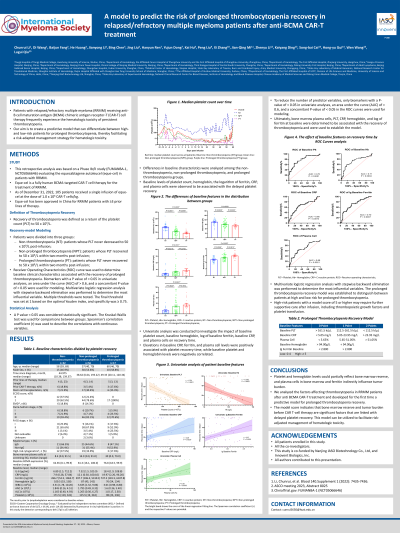Treatment of Relapsed/Refractory Myeloma
Poster Session 2
P-288: A model to predict the risk of prolonged thrombocytopenia recovery in relapsed/refractory multiple myeloma patients after anti-BCMA CAR-T treatment
Thursday, September 28, 2023
12:30 PM - 1:30 PM EEST


Chunrui Li, MD
Prof.
Department of Hematology, Tongji Hospital of Tongji Medical College, Huazhong University of Science and Technology
Wuhan, Hubei, China (People's Republic)
Introduction: Patients with relapsed/refractory multiple myeloma (RRMM) treated with anti-B cell maturation antigen (BCMA) chimeric antigen receptor-T (CAR-T) cell therapy frequently experience the hematologic toxicity of persistent thrombocytopenia. Our aim was to develop a model that distinguishes between patients at high and low risk for prolonged thrombocytopenia, which may be useful for risk-adapted treatment of hematologic toxicity.
Methods: We retrospectively analyzed data from a phase 1b/2 trial of 103 RRMM patients treated with CT103A, a fully human anti- BCMA CAR -T (NCT05066646). Recovery of thrombocytopenia was defined as a rebound in platelet count (PLT) to 50×10^9/L. Patients were divided into three groups: non-thrombocytopenia (patients whose PLT never decreased to 50×10^9/L post-infusion), non-sustained thrombocytopenia (patients whose PLT recovered to 50×10^9/L within two months post- infusion), and prolonged thrombocytopenia (patients whose PLT never recovered to 50×10^9/L within two months post- infusion).
Receiver operating characteristics (ROC) curve was used to determine baseline clinical characteristics associated with the recovery of prolonged thrombocytopenia. Biomarkers with a P value of < 0.05 in univariate analyzes, an area under the curve (AUC) of > 0.6, and a concomitant P value of < 0.05 were used for modeling. Multiple thresholds were tested; the final threshold was set as 1 based on the optimal Youden index, and specificity was ≥ 0.75.
Results: Ultimately, PLT, C reaction protein, plasma cells in bone marrow, hemoglobin, and Ig Ferritin at baseline were determined to be associated with the recovery of thrombocytopenia and were used to establish the model (Table 1).
This model allows prediction of recovery from thrombocytopenia based on baseline data. PLT and hemoglobin levels could partially reflect bone marrow reserve, and plasma cells in bone marrow and ferritin indirectly influence tumor burden. High-risk patients with a model score of 5 or higher may require further supportive care after infusion, including thrombopoietic growth factors and platelet transfusion.
Table 1. Prolonged Thrombocytopenia Recovery Model
Baseline PLT: > 161.5/μL (0 Point), 112.5-161.5 /μL (1 Point), < 112.5/μL (2 Points)
Baseline CRP: < 5.05 mg/L (0 Point), 5.05-23.95 mg/L (1 Point), > 23.95 mg/L (2 Points)
Plasma Cell: < 5.65 % (0 Point), 5.65-51.05% (1 Point), > 51.05% (2 Points)
Baseline Hemoglobin: > 94.00g/L (0 Point), < 94.00g/L (1 Point)
lg Ferritin Baseline: < 2.800 (0 Point), > 2.800 (1 Point)
Note: Low (0-4), High (≥ 5)
Conclusions: We analyzed the factors affecting thrombocytopenia in RRMM patients after anti BCMA CAR -T treatment and developed for the first time a predictive model for prolonged thrombocytopenia recovery. Prolonged thrombocytopenia may occur in patients with low bone marrow reserve and high tumor burden.
Methods: We retrospectively analyzed data from a phase 1b/2 trial of 103 RRMM patients treated with CT103A, a fully human anti- BCMA CAR -T (NCT05066646). Recovery of thrombocytopenia was defined as a rebound in platelet count (PLT) to 50×10^9/L. Patients were divided into three groups: non-thrombocytopenia (patients whose PLT never decreased to 50×10^9/L post-infusion), non-sustained thrombocytopenia (patients whose PLT recovered to 50×10^9/L within two months post- infusion), and prolonged thrombocytopenia (patients whose PLT never recovered to 50×10^9/L within two months post- infusion).
Receiver operating characteristics (ROC) curve was used to determine baseline clinical characteristics associated with the recovery of prolonged thrombocytopenia. Biomarkers with a P value of < 0.05 in univariate analyzes, an area under the curve (AUC) of > 0.6, and a concomitant P value of < 0.05 were used for modeling. Multiple thresholds were tested; the final threshold was set as 1 based on the optimal Youden index, and specificity was ≥ 0.75.
Results: Ultimately, PLT, C reaction protein, plasma cells in bone marrow, hemoglobin, and Ig Ferritin at baseline were determined to be associated with the recovery of thrombocytopenia and were used to establish the model (Table 1).
This model allows prediction of recovery from thrombocytopenia based on baseline data. PLT and hemoglobin levels could partially reflect bone marrow reserve, and plasma cells in bone marrow and ferritin indirectly influence tumor burden. High-risk patients with a model score of 5 or higher may require further supportive care after infusion, including thrombopoietic growth factors and platelet transfusion.
Table 1. Prolonged Thrombocytopenia Recovery Model
Baseline PLT: > 161.5/μL (0 Point), 112.5-161.5 /μL (1 Point), < 112.5/μL (2 Points)
Baseline CRP: < 5.05 mg/L (0 Point), 5.05-23.95 mg/L (1 Point), > 23.95 mg/L (2 Points)
Plasma Cell: < 5.65 % (0 Point), 5.65-51.05% (1 Point), > 51.05% (2 Points)
Baseline Hemoglobin: > 94.00g/L (0 Point), < 94.00g/L (1 Point)
lg Ferritin Baseline: < 2.800 (0 Point), > 2.800 (1 Point)
Note: Low (0-4), High (≥ 5)
Conclusions: We analyzed the factors affecting thrombocytopenia in RRMM patients after anti BCMA CAR -T treatment and developed for the first time a predictive model for prolonged thrombocytopenia recovery. Prolonged thrombocytopenia may occur in patients with low bone marrow reserve and high tumor burden.
